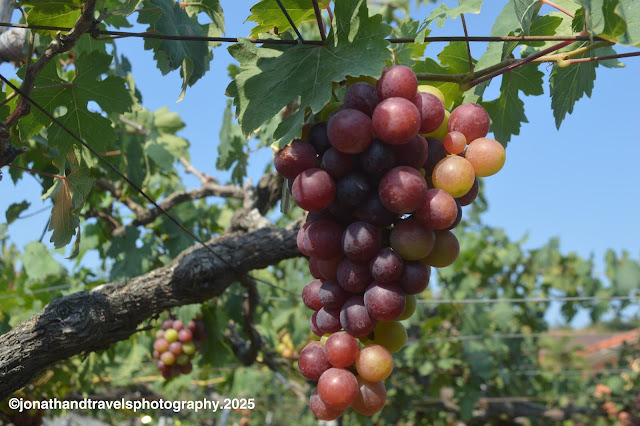When people have heard of La Union, the first thing that comes into their minds are beach resorts and surfing haven. However, while driving along the highways of Elyu (LU is a portmanteau of La Union), you can see people holding tarpaulins and markers "Grape Picking" or "Grapes Farm" which others might think that these fruits can possibly grow in a tropical country and it is usually expected to grow in temperate countries such as Italy, USA, and France.
 |
| Grapes farming is one of the agricultural activities in La Union that boost its tourism. |
 |
| The ideal time to visit grape farms in Bauang is dry season where grapes are sweet. |
Located 10 kilometers away from the provincial capital San Fernando City, Bauang known as the "Fruit Basket of La Union" where you can buy and see numerous fruits such as banana, melon, dragon fruit, papaya, and guava to name a few. Furthermore, Bauang is an agricultural municipality where you can see rice and tobacco farms, as well with the source of livelihood of people are relying on farming. Therefore, grape farming is one of the most common agricultural activities in the area because of its topography and climate.
 |
| Right pick for fresh, sweet grapes commonly found in La Union during the summer season. |
 |
| Grapes became a vital product in Bauang, La Union as it indicates an economic boom in the town. |
Grape farming in La Union started during the 1970's and it became an agricultural activity and source of livelihood among the residents of Bauang. Numerous grape farms stretched along the town's vicinity include Lomboy, Manguerra, Calica, and Gapuz, where the latter one had the chance to visit.
The province's topographical features - long, sandy coastline facing the West Philippine Sea beside the foothills of Cordillera mountains - made it a perfect place for grape farming. Furthermore, the grape variety that can be found in the province is the Red Cardinal which can be planted and cultivated in sandy loam soil, along with the long, dry season in the region. The vineyards are measured five-feet tall overhead in order for the air circulation.
 |
| Fresh grapes |
 |
| Fruit juices from grapes, guyabano, mangosteen, and blueberry. |
Grapes are always harvested in the province, but the best time to harvest is during the dry season which can be held during April and picking season happened from March to May where the grapes are ripe. Also, the Red Cardinal Grape is also found in tropical countries, as exemplified in Vietnam and Thailand, where they also harvest grapes in the said variety.
Fruit juices and wines made from grapes, mangosteen, guyabano, and blueberry are also available in grape farms in the province which is also a must-try if you visit La Union. Lastly, grape farming is also practiced in the neighboring towns of Caba and Aringay which shared the same geographical features.
La Union is not just only a place for surfing and beach hopping. You can also try their grapes and other fruits in the town of Bauang for a sweet side trip.
Date of Travel: April 27, 2025





















.JPG)
.jpg)

.jpg)































